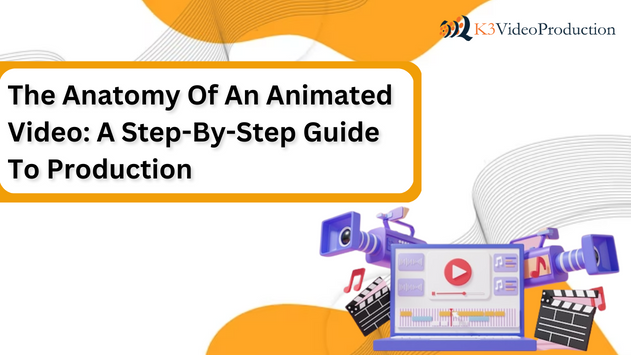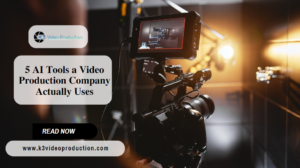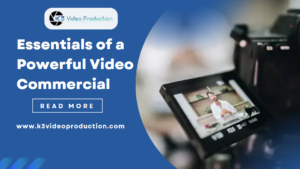Anatomy Of An Animated Video: Step-By-Step Guide To Production
Table of Contents
ToggleInvesting in an animated video can have many benefits, but you might need to learn what the actual animation process involves.
You can easily convey your company’s message through animated videos, such as explainer video production and whiteboard animations, regardless of how complex your product or service may seem at first glance. Animation does not limit the story to the limits of reality like an animation video production – you can let your imagination run wild! How does that work exactly?
You need to be prepared for the animation steps ahead. In this post, I’ll explain how to make animated video production. Then, it’s time to get started!

What Are The Steps Of An Animated Video Production Process?
Animated stories and imaginative worlds have the power to captivate audiences through visual storytelling. However, from traditional hand-drawn animation to cutting-edge 3D CGI, animation has evolved into a complex and multi-faceted process that requires careful planning, creativity, and technical expertise. A concept for the final product animation production process will be explored.
Step 1: Conceptualization And Pre-Production
The first step in the animation production process is conceptualization and pre-production. This is the stage where the animation’s idea, story, and message are conceptualized and refined. It involves understanding the purpose and target audience of the animation, defining the key objectives, and developing the story and characters. During this stage, the script is written, storyboards are created, and the visual design is planned.
The script serves as the blueprint for the animation, outlining the characters’ dialogue, narration, and actions. Storyboarding is the process of creating a sequence of visual sketches or frames that depict the key scenes and shots of the animation, helping to visualize the final product. The visual design is also developed during pre-production, including the characters, backgrounds, objects, and props. The design is typically based on the storyboard and aligns with the animation’s overall visual style and tone.
Step 2: Layout And Animation Planning
The second step in the animated video production process is layout and animation planning. This is where the visual elements of the animation are organized and prepared for animation. The layout process involves arranging the characters, objects, and backgrounds in a composition that conveys the desired visual storytelling. This includes determining the camera angles, camera movements, and shot transitions.
In addition, the layout serves as a guide for the animators, providing them with the positioning and movement of the visual elements. Animation planning is also done during this stage, where the animators plan the motion and timing of the animation. This involves determining the characters’ poses, expressions, and movements and planning the keyframes or frames that capture the motion. Animation planning is crucial to ensure smooth and fluid animation that conveys the desired emotions and actions.
Step 3: Animation
The third step in the animation production process is the animation stage. This is where the visual elements of the animation come to life through movement and motion. The animators use various techniques to animate the characters, objects, and backgrounds based on the layout and animation planning. This can include hand-drawn animation, digital animation, 3D animation, stop-motion animation, or a combination of techniques, depending on the style and type of animation being created.
First, the animators create a sequence of frames or keyframes that capture the motion and timing of the animation. Then, the animated video company carefully crafts the characters’ poses, expressions, and movements to bring them to life and convey the desired emotions and actions. Animation requires patience, creativity, and attention to detail to create realistic and visually appealing motion.
Step 4: Voiceover And Sound Design
The fourth step in the animation production process is the addition of voiceover and sound design. Voiceover is the recording of the narration or dialogue accompanying the animation. This can be done by hiring professional voice actors or recording in-house, depending on the budget and resources available. The voiceover is then synced with the animation to create a cohesive and synchronized animation.
Sound design involves adding sound effects, music, and other audio elements that enhance the overall experience of the animation. Sound effects are added to bring realism and depth to the animation, while music sets the tone and mood, and other audio elements add to the overall ambiance. The voiceover and sound design are crucial in creating a fully immersive and engaging animation that resonates with the audience.
Step 5: Post-Production And Editing
The fifth step in creating an animated video is post-production and editing. This is the final stage, where all the video elements are brought together and polished to create the final product. The animation, voiceover, sound effects, and music are combined and edited to create a seamless and visually appealing video. Transitions, text overlays, and other visual effects may be added to enhance the video further.
Finally, the video is reviewed and refined based on feedback from the team or clients, and revisions are made until the video meets the desired quality and standards.
Step 6: Illustration And Animation
We have all been waiting for this moment! We began animating the illustrations once you approved all of the previous phases. They create a movement for characters and other elements on the screen using sophisticated software. It should come as no surprise that this stage is one of the most time-consuming parts of the 2D animation process.
Step 7: Adding Sound Effects
It’s almost time! Now that the visual part of the video is finished, it’s time to concentrate on the audio. The next step of the animation production process involves editing and synchronizing voiceovers, sound effects, and music. Our team pays close attention to ensuring your animated video has the highest quality audio and music. It’s finally here! Animation has been completed. The video needs only to be adjusted to your liking.
Types of Animation
Animation is a diverse and versatile art form that can take on many different styles and techniques. From traditional hand-drawn animation to modern computer-generated imagery (CGI), numerous types of animation can be used to create visually stunning and engaging content. In this article, we will explore some of the most common types of animation and their unique characteristics.
-
Traditional Hand-Drawn Animation:
Traditional hand-drawn animation, also known as 2D animation, is one of the oldest forms of animation. It involves creating each frame of the animation by hand, usually on paper, and then photographing or scanning the frames to create the illusion of motion. Hand-drawn animation requires a high level of artistic skill and craftsmanship, as each frame is carefully drawn and colored to create a smooth and fluid animation. Classic animated films like Snow White and the Seven Dwarfs and The Little Mermaid are examples of traditional hand-drawn animation.
-
Stop-Motion Animation:
Stop-motion animation is a unique type of animation that involves capturing a series of photographs or frames of physical objects or puppets and then playing them back in sequence to create the illusion of movement. Stop-motion animation can be done using various materials, such as clay (claymation), paper (cut-out animation), or even real-life objects (object animation). Popular stop-motion films include Wallace and Gromit and The Nightmare Before Christmas.
-
3D Computer-Generated Animation:
3D computer-generated animation, also known as CGI, uses digital models and computer software to create three-dimensional characters, objects, and environments. CGI animation allows for highly realistic and detailed visuals commonly used in movies, video games, and commercials. Pixar films like Toy Story and Finding Nemo are examples of 3D CGI animation.
-
Motion Graphics:
Motion graphics is a type of animation that combines graphic design and animation to create visually dynamic and engaging content. It involves using text, shapes, and other animated graphic elements to create motion and visual effects. Motion graphics are often used in advertisements, title sequences, and explainer videos.
-
Cut-Out Animation:
Cut-out animation is a type of 2D animation that uses pre-existing images or characters cut out from paper or other materials and then manipulated to create movement. The cut-out pieces are typically attached to joints or hinges, allowing them to be moved and animated. Cut-out animation is often used in television shows and commercials.
-
Claymation:
Claymation, also known as clay animation or plasticine animation, is a type of stop-motion animation that uses modeling clay or plasticine to create characters and objects. The clay is sculpted and manipulated to create movement, and each frame is captured to create the final animation. Wallace and Gromit and Chicken Run are examples of claymation films.
-
Pixilation:
Pixilation is a type of stop-motion animation that involves using live actors or objects as the characters in the animation. The actors or objects are posed and photographed frame by frame, and the frames are played back in sequence to create the illusion of movement. Pixilation can create unique and surreal visual effects and is often used in experimental or avant-garde animations.
-
Rotoscoping:
Rotoscoping is a type of animation that involves tracing live-action footage frame by frame to create an animated version of the footage. The traced frames are then played back in sequence to create the animation. Rotoscoping is often combined with other animation techniques to create a realistic or stylized look.
In conclusion, the production process of an explainer video production company involves various stages, from concept development to post-production. It includes steps such as scriptwriting, storyboarding, character design, animation, sound design, and editing. Each step requires careful planning, creativity, and technical skills to bring the vision to life. Understanding the anatomy of an animated video and following a step-by-step guide can help ensure a smooth and successful production process, resulting in a visually captivating and engaging final product.
FAQs:
Q: What are the key elements of animated video production?
A: The key elements of an animated video production include concept development, scriptwriting, storyboarding, character design, animation techniques, sound design, and post-production editing.
Q: How long does it take to produce an animated video?
A: The production timeline for an animated video can vary depending on the project’s complexity, the animation style, and the resources available. It can range from a few weeks to several months or even longer.
Q: What are some common challenges in animated video production?
A: Some common challenges in animated video production include managing time and resources, ensuring consistency in style and continuity in storytelling, coordinating team members, and maintaining communication and feedback throughout the production process.
Q: What are some tips for successful animated video production?
A: Some tips for a successful animated video production include thorough planning and pre-production, clear communication among team members, adherence to a timeline, regular feedback and revisions, and attention to detail in animation, sound design, and editing.
Q: What are the different animation techniques used in video production?
A: There are various types of animation techniques used in video production, including traditional hand-drawn animation, stop-motion animation, 3D computer-generated animation, motion graphics, cut-out animation, claymation, pixilation, and rotoscoping.
Q: How important is storytelling in animated video production?
A: Storytelling is a crucial element in animated video production, as it drives the narrative, engages the audience, and conveys the intended message or emotion. A well-crafted story enhances the impact and effectiveness of an animated video.
Read our article:Top Benefits Of Corporate Video Production For Chicago Businesses








